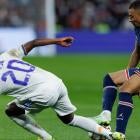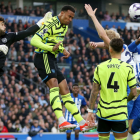Bridging the gap between the football world and the refereeing community, The Final Decision will analyze the application of the Laws of the Game (LOTG), VAR protocol, and semi-automated offside technology in the UEFA Champions League and more.
Take a deeper look into whether the decisions were correct, and if not, why.
In the first edition, we dive into semi-automated offside technology (SAOT) permanent presence in the Champions League, how VAR works and how Real Sociedad's penalty against Manchester United demonstrates the current interpretation referees are being required to apply. Then we end on a refreshing note of another barrier being broken down.
Modern Football 2.0: Semi-automated offside technology (SAOT)
After two-plus years of offline trials with FIFA and UEFA competitions, semi-automated offside technology made its debut in Champions League. It's primary purpose:
- Enhancing the Flow of the Game. It speeds up the time it takes a VAR to set the offside lines to determine whether a player is in an offside position.
- Consistency of the Decision. Establishes accuracy and credibility in the decision that it is not a subjective decision by the VAR.
SAOT in Champions League has 10 cameras installed in the stadium that are calibrated to be synchronized and equipped with limb-tracking technology so it can track every player, 29 different body points per player, and the ball.
The information is relayed to the SAOT operator in real time so when a potential offside occurs the VAR receives the exact moment when the ball was kicked with a 3-D wall visual of where the offside infraction occurred. The VAR has final say confirming both the kick point and whether the wall is drawn properly on the 3-D module before it is recommended to the referee that there is an individual in an offside position. The on-field referee team is not automatically notified like goal-line technology. The communication still goes first to the VAR and then if confirmed to the referee through the VAR's recommendation.
Do referees like SOAT?
The simple answer, yes. In very tight offside decisions a frame forward or a frame back can be all the difference in whether someone is marginally offside. It is difficult to certify which frame at times should be set based on the kick point of the ball from an attacker's teammate when it is very close. This results in the VAR team ensuring they are confident they have the right kick point by going through several of the available camera angles that are synchronized to confirm it. This takes time.
Based on the FIFA studies, SAOT can reduce the average time from 70 seconds to 25 seconds to determine offside. Trust me, when you are waiting to hear a "check complete" or an "I recommend" from your VAR, every second feels like a minute, particularly in a stadium with thousands of people. This not only enhances flow of the game and consistency for the viewers/fans but also for the referees to feel confident in marginal offside calls.
Craving even more coverage of the world's game? Listen below and follow ¡Qué Golazo! A Daily CBS Soccer Podcast where we take you beyond the pitch and around the globe for commentary, previews, recaps and more.
3-D Graphics Sell the Decisions Credibility
To cure the football community's concerns about credibility and consistency on marginal offsides, SAOT not only eliminates the argument for inaccuracy but it also shows the viewers the facts in a 3-D rendering.
As stated by CBS Sports' Ray Hudson on the color commentary, "this is 3-D without the need for 3-D glasses."
SAOT images hit the screen quickly in the Champions league after Andreas Cornelius was deemed offside for FC Copenhagen's goal vs. Borussia Dortmund in the 88th minute. The images show the part of the body with a sensor ring that draws the viewer's attention to the body part that is breaking the wall and then shows a squared image of the players to further support the decision.
Chelsea's overturned goal in the 49th minute against Dinamo Zagreb:

And in the 50th minute of Atletico vs. Porto, the assistant referee's delayed offside call on Atletico's Rodrigo De Paul's in the APP before the goal was scored was confirmed:
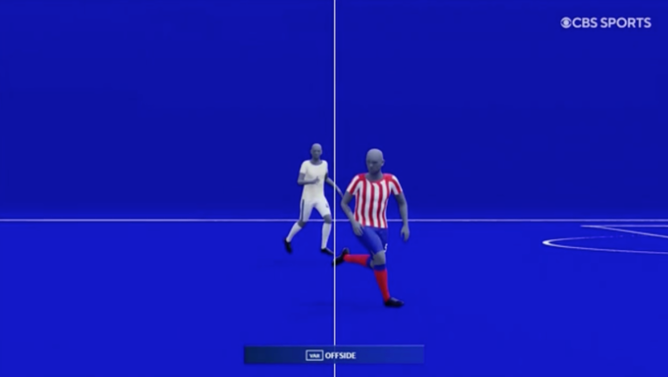
Offside by a toenail is back
SAOT technology not only brings flow and credibility, it also brings back "toenail offsides." With the accurate technology, any application for "tolerance" in setting the offside lines wby the VAR is no longer needed. This is confirmed in the 73rd minute of the Club Brugge vs. Leverkusen game where Jonathan Tah's toes led him to be in an offside position and he interfered with an opponent as he did not touch the ball but impacted the defender resulting in Patrick Schick's goal being disallowed.
Now all that is left to be seen is whether the football community will accept toe-offsides with the latest technology or seek for IFAB to make further modifications to the system.
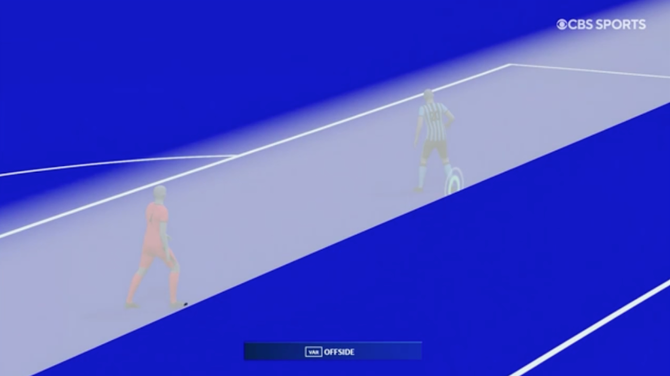

VAR and modern technology is working
The introduction of technology for the officials is the greatest change to the game. It has the ability to immediately impact a game in a way never done before by getting the decisions closer to perfection and closing the gap for any errors to occur.
Whether you like it or not, it is now permanently here, and in the 24th minute of the Barcelona vs. Viktoria Plzen match, VAR reminded everyone why it was created in the first place.

The initial decision by the on-field referee was a penalty kick for Viktoria and red card to Barcelona's Andreas Christensen. With VAR, the decision was corrected to a direct free kick for Barcelona coming out and yellow card to Viktoria's Jhon Mosquera for reckless use of his arm/elbow contacting Christiansen's face before he was fouled.
This play magnifies how difficult it is for the referee and near assistant referee to be able to fully appreciate and see fouls occurring extremely close to one another but in different parts -- upper vs. lower body at full speed. A flick on to Mosquera from a long ball and Mosquera's acute use of his body to cancel Christensen puts the center referee in a more direct line behind the next phase of play, not allowing him to appreciate the elbow to Christiansen's face. As the referee is focused from being in a great position and angle to quickly having to adjust, he is directly behind the play which made it easier to lose sight of the upper head contact and see only Christensen's lower body contact.
Without VAR, the referees would have been in the center of controversy and Barcelona would have been down to 10 players with over 65 minutes left to play in their opening Champions League match.
Penalty against Man United for handling against Martinez is the correct decision
I'm not saying you have to like the application, but this is how the current law and its interpretation will be applied in the foreseeable future.
Right after VAR we have the next biggest change in the LOTG (Laws Of The Game) in 2019-2020. These six principles guided the changes and still do when applying the current interpretation:
- Football does not accept a goal scored directly by a hand/arm even if accidental.
- Football expects players to be penalized for handling if they gain possession/control from the ball and gain a major advantage (score goal or goal scoring opportunity).
- Natural for players to put their arm between their body and the ground to support when falling.
- The hand/arm above the shoulder height is rarely a natural position.
- Players "take a risk" by having their arm/hand above their shoulders and when they are sliding.
The major rewrite to the LOTG in 2019-20 was an attempt to provide greater clarity for handling and explain when non-deliberate contact was not penalized. The introduction of words like "unnaturally bigger" and "above/beyond shoulder level" made its appearance. Also, the LOTG clarified that it was not handling if it came directly off the player or another player who was close so long as the hand was close to the body or when the hand/arm is in between the body and the ground to support the body (supporting arm) during a fall or slide.
The 2020-21 LOTG saw a rule addition in an accidental handling by a teammate leading up to a goal would negate the goal, as seen in the Fulham vs. Tottenham game where Josh Maja's equalizer was disallowed after VAR recommended it down to be overturned due to accidentally touching teammate Mario Lemina's hand, which was in a natural position before going to Maja.
As quickly as it entered, the accidental handling by a teammate was eliminated from law which leads us to the 2021-22 LOTG change which is the same as the current 2022-23 LOTG but provides room for interpretation as the key buzz words are now "unnaturally bigger," "justifiable" and "risk."
"Touches the ball with their hand/arm when it has made their body unnaturally bigger. A player is considered to have made their body unnaturally bigger when the position of their hand/arm is not a consequence of, or justifiable by, the player's body movement for that specific situation. By having their hand/arm in such a position, the player takes a risk of their hand/arm being hit by the ball and being penalized."
So how do officials use the latest LOTG to get consistency across the world as to handling fouls? They are trained on using the FIFA "considerations," which is a series of questions created by FIFA that help guide a referee to apply the questions to a specific situation to arrive at a generally accepted outcome. Those considerations are derived from the six principles mentioned above which FIFA states that football accepts these principles to be true.
VAR called this a penalty for Real Sociedad.
— CBS Sports Golazo ⚽️ (@CBSSportsGolazo) September 8, 2022
Do you agree with the decision? 👀 pic.twitter.com/qQ6WjST0SI
So when breaking down Lisandro Martinez's handling offense, here is how you must break it down to understand why the referee's decision is ultimately the final decision preferred.
- This scenario is a close-range shot on goal by David Silva on the top of the penalty area.
- Martinez is taking a risk that it could hit his hand/arm by making a desperate last-minute play by slide tackling in hopes of blocking the shot on goal.
- If the ball had not hit the back of Martinez's arm, near or on his elbow, the ball would have continued to goal.
- It is important to highlight that there is no legal part of Martinez's body part that would have blocked the shot if it had not hit the back of his arm/elbow.
- The arm that was hit was Martinez's outside arm or barrier arm, meaning it was not his right arm which was acting as his support arm while he was sliding in to block the shot.
With those facts taken together, you must then ask whether it is justifiable to allow Martinez off the hook for preventing a shot on goal by Silva with a part of his arm that is illegal to play with.
If the football community's acceptance of the six principles remain true, then Martinez must be penalized. Football expects a player to be penalized for handball if they gain a major advantage (here denying the shot on goal that would not have hit any other legal part of the body) by the contact. In this specific situation, Martinez is said to be "taking a risk" by sliding into the challenge and it hitting his non-supporting arm between his body and the ground (his left arm).
This one is a good one to tackle as the cries of injustice because it came off Martinez's leg and his arm can be argued close to his body. But the handling offense is an "impact based" law, meaning its focus is on whether the offense had an impact and should be punished. Therefore, the only outcome on Martinez for stopping a shot on goal is handling, penalty and yellow card.
Keep in mind, this doesn't mean you have to like the outcome even though you come to this result. Imagine how Silva felt when he saw his shot on goal denied by a contact from the arm when it wasn't there on his initial shot?
Champions League continues to break down barriers
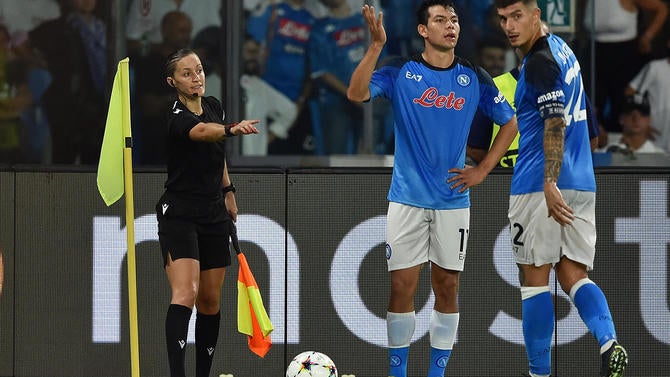
With everyone all upset still and debating Manchester United's penalty for handling, we end it on a good note. Guadalupe Porras Ayuso became the first female Spanish referee to participate in a match of the highest European club competition as an assistant to the referee team of Napoli-Liverpool. As women in soccer around the world continue to break down barriers in football, and soon this won't be breaking news, women referees are following closely behind. Ayuso is a FIFA referee since 2014 and current assistant referee in La Liga. These milestones deserve acknowledgement as she may be the first but not the last.













